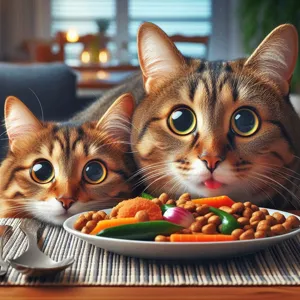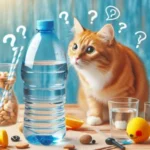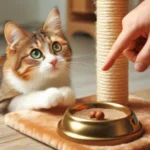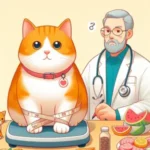Cats can be enigmatic creatures, often leaving their owners puzzled with their quirky behaviors and sudden changes in habits.
One such mystery that many cat parents encounter is a sudden increase in appetite. While it may seem like a simple case of your feline friend just enjoying their meals a little too much, a dramatic shift in eating patterns can signal underlying health issues that warrant your attention. Understanding the reasons behind your cat’s newfound voraciousness is essential not only for their well-being but also for your peace of mind. In this blog post, we will explore the various factors that may contribute to this change in appetite, from dietary adjustments and stressors to potential health concerns. Armed with knowledge and insights, you’ll be better equipped to ensure your beloved companion remains happy, healthy, and satisfied.
1. Introduction: Why is my cat suddenly eating more?

Cats, those enigmatic companions with their playful antics and independent spirits, often leave us puzzled by their behaviors. One moment they’re daintily nibbling at their kibble, and the next, they’re voraciously devouring every morsel in sight. If you’ve recently noticed a sudden increase in your feline friend’s appetite, you’re not alone. Many cat owners find themselves asking, “Why is my cat suddenly eating more?”
This change in eating habits can stem from a variety of reasons, ranging from the benign to the concerning. Cats may become more hungry due to changes in their environment, stress, or even boredom. Perhaps a new pet has joined the household, or a recent move has unsettled their routine. In such cases, their increased appetite could be a response to anxiety or a desire for comfort.
However, a notable uptick in hunger can also signal underlying health issues. Conditions such as hyperthyroidism, diabetes, or even certain infections can lead to excessive eating, prompting a visit to the vet for an accurate diagnosis. Understanding the nuances behind your cat’s behavior is crucial—not just for their well-being, but also for your peace of mind.
In this post, we will delve deeper into the various causes of increased appetite in cats, explore the potential health implications, and provide you with actionable insights to ensure your furry friend remains happy and healthy. So, let’s begin this journey to decode the mystery behind your cat’s newfound appetite!
2. Normal vs. Abnormal Appetite: Understanding the Difference
When it comes to your feline friend’s eating habits, understanding the difference between a normal increase in appetite and a potentially concerning one is crucial for their health and well-being. Cats, like humans, can experience fluctuations in their appetite due to a variety of factors, and discerning the cause can help you determine whether it’s simply a change in lifestyle or a signal of an underlying health issue.
A **normal appetite** for cats typically varies by age, activity level, and breed, but most healthy adult cats will consume roughly 24 to 35 calories per pound of body weight a day. If your cat seems to be a little hungrier than usual after a change in routine—perhaps due to increased playtime or a shift in their environment—this might simply be a response to their heightened activity levels. Kittens and young cats, known for their boundless energy, may also exhibit increased appetites as they grow and develop.
On the flip side, an **abnormal appetite**, or polyphagia, can be a sign of health concerns. If your cat is suddenly eating significantly more than usual and displaying behaviors such as begging for food, scavenging, or even raiding the pantry, it’s time to take notice. Conditions such as diabetes, hyperthyroidism, or even certain types of infections can lead to increased hunger. Additionally, stress or anxiety can lead some cats to seek comfort in food, so consider any recent changes in their environment that might be impacting their emotional state.
To gauge whether your cat’s appetite is within a healthy range, observe their eating patterns and behaviors closely. A sudden increase in appetite over a short period, especially if accompanied by other symptoms such as weight loss, increased thirst, or lethargy, should prompt a visit to the veterinarian. Understanding these nuances will not only help you keep your kitty healthy but also give you peace of mind as you navigate the complexities of their dietary habits.
3. Common Causes of Increased Appetite in Cats

When your feline friend suddenly begins to exhibit an insatiable appetite, it can be a cause for concern. Understanding the common causes of increased appetite in cats is essential for every cat owner.
One of the primary reasons cats may eat more is simply due to their natural instincts and behavior. Cats are instinctual hunters, and when they perceive their environment as safe, they may feel more inclined to eat. This could be particularly true if you’ve recently changed your cat’s living situation or if they’ve found a new source of food outside of their regular diet.
Another common cause is hyperthyroidism, a condition often seen in older cats. This disorder occurs when the thyroid gland produces excessive hormones, leading to increased metabolism. As a result, your cat may seem constantly hungry, even after consuming their regular meals. If you notice other symptoms, such as weight loss, increased thirst, or hyperactivity, it’s crucial to consult your veterinarian for further evaluation.
Diabetes mellitus is another potential culprit. In diabetic cats, the body struggles to regulate blood sugar levels, leading to increased hunger as the body attempts to compensate for energy loss. Additional signs may include excessive thirst, frequent urination, and lethargy.
Lastly, stress can also manifest in an increased appetite. Cats may respond to changes in their environment, such as new pets, moving homes, or changes in family dynamics, by either overeating or under-eating. If your cat’s increased appetite coincides with any lifestyle changes, consider monitoring their behavior closely and providing a stable environment.
In conclusion, while a sudden increase in appetite can sometimes be attributed to benign factors, it’s essential to keep an eye on your cat’s overall health and behavior. If you have any concerns, don’t hesitate to reach out to your veterinarian for advice and possible treatment options. Understanding the nuances behind your cat’s appetite can help you ensure their well-being and happiness.
4. Medical Conditions Associated with Increased Hunger
When your feline friend suddenly starts eating like a bottomless pit, it’s crucial to consider potential underlying medical conditions that could be driving this behavior. While increased appetite might occasionally be attributed to a change in routine or a new food, persistent or drastic changes warrant attention.
One common condition to watch for is hyperthyroidism, particularly in older cats. This disorder results from an overproduction of thyroid hormones, leading to increased metabolism and, consequently, an insatiable hunger. Other symptoms to look out for include weight loss, increased activity levels, and changes in behavior.
Diabetes mellitus is another serious condition that can cause increased appetite in cats. In diabetic cats, the body struggles to regulate blood sugar levels, prompting them to consume more food in an attempt to acquire the energy they are missing. Along with voracious eating, you might notice other signs such as excessive thirst and frequent urination.
Gastrointestinal disorders, such as inflammatory bowel disease (IBD) or parasites, can also lead to increased hunger. These conditions can interfere with nutrient absorption, causing your cat to feel hungry despite having eaten. If you notice your cat exhibiting signs of distress—such as vomiting, diarrhea, or lethargy—it’s time to consult your veterinarian.
Lastly, certain tumors, particularly insulinomas, can result in abnormal hunger patterns. These tumors secrete excessive amounts of insulin, which can lead to fluctuating blood sugar levels and increased appetite, alongside other symptoms that may be concerning.
Monitoring your cat’s eating habits is essential, as any drastic change can be a sign of something more serious. If you find that your furry companion is eating far more than usual, it’s best to schedule a veterinary appointment for a thorough examination. Understanding the potential medical conditions linked to increased appetite will not only help you care for your cat better but also ensure they lead a healthy and happy life.
5. Behavioral Factors That May Contribute to Appetite Changes

When your feline friend suddenly begins to exhibit an insatiable appetite, it’s essential to consider the behavioral factors that may be at play. Cats are creatures of habit, and any disruption in their environment or routine can lead to changes in their eating patterns.
One significant factor is stress. Cats can be sensitive to changes in their surroundings, such as the arrival of a new pet, a move to a new home, or even alterations in daily schedules. Stress can manifest in various ways, and for some cats, it may trigger a desire to eat more as a coping mechanism. If your cat seems more anxious or withdrawn alongside its increased appetite, it may be time to assess the stressors in its environment.
Boredom is another potential culprit. Cats, particularly those that are indoor-only, can become bored without sufficient stimulation. This lack of engagement can lead them to seek out food as a form of entertainment. Consider enriching your cat’s environment with interactive toys, climbing structures, or designated playtime to keep their minds active and engaged.
Additionally, behavioral changes can be influenced by habit. If your cat has become accustomed to free-feeding or grazing throughout the day, it may develop a tendency to overeat. Establishing a consistent feeding schedule with portion control can help regulate their appetite and prevent unhealthy weight gain.
Lastly, changes in social dynamics within your household can also impact your cat’s behavior. If there are conflicts with other pets or changes in the human household, your cat may turn to food as a source of comfort. Observing your cat’s interactions with other pets and ensuring a harmonious environment can help mitigate these issues.
Understanding the behavioral factors that contribute to your cat’s increased appetite is crucial for addressing the issue holistically. By creating a stable, engaging, and stress-free environment, you can help your feline companion find balance and health in their eating habits.
6. The Role of Diet and Nutrition in Cat Appetite
Diet and nutrition play a crucial role in understanding your cat’s sudden increase in appetite. Just like humans, a cat’s dietary needs can vary significantly based on their age, activity level, and overall health. If you’ve noticed your feline friend suddenly exhibiting a ravenous hunger, it might be time to take a closer look at what’s in their food bowl and whether it is meeting their nutritional requirements.
First and foremost, the quality of your cat’s food is paramount. High-quality, protein-rich diets are essential for maintaining your cat’s energy levels and overall health, but if the food lacks adequate nutrients, your cat may feel unsatisfied and seek more sustenance. Cats are obligate carnivores, meaning that their bodies are designed to thrive on a diet primarily composed of meat. If their food is high in fillers, grains, or carbohydrates, they might not be getting the nutrition they need, causing them to eat more in an attempt to fulfill their dietary requirements.
Additionally, consider any recent changes to their diet. A sudden switch to a new brand or type of food can confuse your cat’s digestive system, leading to a spike in appetite as their body adjusts to unfamiliar ingredients. If you have changed their diet recently, it’s advisable to transition gradually, mixing the old food with the new to help prevent gastrointestinal upset.
It’s also essential to be aware of any weight management formulas you may be using. While these diets are designed to help overweight cats lose weight, they can sometimes leave them feeling hungry if they aren’t formulated correctly. If your cat seems to be begging for more food, it might be a sign that they aren’t getting enough calories to support their needs.
Lastly, pay attention to portion sizes. Many cat owners underestimate how much food their pets truly require. Consulting with your veterinarian can help you determine the proper serving size based on your cat’s weight, age, and activity level. Ensuring your cat receives the right balance of nutrients and calories can lead to a more satisfied, healthier feline companion.
In summary, if your cat has developed a sudden increase in appetite, it’s essential to evaluate their diet and nutrition carefully. By understanding the role these factors play, you can help your furry friend achieve optimal health and prevent any unwanted health issues down the line.
7. How to Monitor Your Cat’s Eating Habits

Monitoring your cat’s eating habits is crucial for understanding their health and well-being, especially when you notice a sudden increase in appetite. By keeping a close eye on their feeding routine, you can gather valuable insights that may help identify any underlying issues or changes in behavior.
Start by establishing a consistent feeding schedule. Whether you choose to feed your cat once or twice a day, stick to the same times to create a sense of routine. This consistency helps you track any deviations in their behavior. Make note of how much food you offer and how much your cat consumes at each feeding. Using a measuring cup can help you accurately gauge portion sizes, ensuring that you’re aware of any changes in their intake.
Keep a journal or use a pet tracking app to log your observations. Record the amount of food consumed, any changes in the type of food offered, and any unusual behaviors, such as begging for food or scavenging between meals. This documentation can be invaluable when discussing your cat’s appetite with your veterinarian.
Additionally, pay attention to your cat’s demeanor during mealtimes. Is your cat eating eagerly and finishing their meal quickly, or do they seem disinterested and pick at their food? An increase in appetite can sometimes indicate stress or anxiety, so observe any changes in their environment or routine that may coincide with their eating habits.
Lastly, consider the impact of treats and snacks. Cats can be particularly persuasive when it comes to extra treats, which can skew your understanding of their regular eating patterns. Limit treats and monitor how they affect your cat’s overall appetite.
By closely monitoring your cat’s eating habits, you can provide your veterinarian with a detailed overview that will aid in diagnosing any potential health issues. Remember, an increase in appetite can be a sign of various conditions, so staying vigilant is key to ensuring your feline friend remains healthy and happy.
8. When to Consult a Veterinarian
While an increased appetite in cats can occasionally be attributed to benign factors such as changes in their environment, activity levels, or diet, there are times when it signals a more serious underlying issue. Recognizing when to consult a veterinarian is crucial for your cat’s health and well-being.
If you notice a sudden and significant increase in your cat’s appetite that persists over more than a few days, it’s time to take action. Pay attention to other accompanying symptoms that may arise. Is your cat drinking more water than usual? Have you observed any changes in their weight—either gaining or losing? Are they exhibiting unusual behaviors, such as excessive grooming, lethargy, or restlessness? These signs can indicate potential health problems that require professional evaluation.
Certain medical conditions, such as diabetes, hyperthyroidism, or gastrointestinal disorders, can lead to increased hunger. These ailments are often accompanied by other symptoms that can sometimes be subtle, making it easy to overlook them. For example, diabetes might present itself with increased thirst and urination, while hyperthyroidism can cause weight loss despite a voracious appetite.
Additionally, if your cat starts scavenging for food or eating non-food items, this could indicate a behavioral issue or a nutritional deficiency that needs to be addressed.
When in doubt, err on the side of caution. A visit to the veterinarian can provide peace of mind and ensure that your feline friend remains healthy and happy. Early intervention is key, as many conditions are easier to treat when caught early. Your veterinarian will conduct a thorough examination, which may include blood tests and other diagnostic tools, to determine the root cause of your cat’s increased appetite and recommend an appropriate course of action. Remember, your cat relies on you to advocate for their health, so don’t hesitate to seek professional guidance when needed.
9. Diagnosing the Underlying Issue: What to Expect at the Vet
When your feline companion suddenly develops an insatiable appetite, it’s crucial to seek veterinary assistance to uncover the underlying issue. A visit to the vet can seem daunting, but understanding what to expect can help ease your concerns and prepare you for a thorough assessment of your cat’s health.
Upon arrival, the vet will first conduct a comprehensive physical examination. This typically includes checking your cat’s weight, body condition, and overall demeanor. The veterinarian will palpate the abdomen to identify any abnormalities, and they may also assess your cat’s hydration levels. It’s vital to provide your vet with detailed information about your cat’s eating habits, any recent changes in behavior, and any additional symptoms you may have noticed, such as increased thirst, lethargy, or changes in litter box habits.
Following the physical examination, the vet may recommend diagnostic tests to pinpoint the issue. Blood tests can reveal a wealth of information, including thyroid function, organ health, and glucose levels. Urinalysis may also be necessary to check for infections or diabetes. In some cases, imaging tests like X-rays or ultrasounds might be required to examine internal organs and identify potential tumorous growths or gastrointestinal issues.
Throughout this process, don’t hesitate to ask questions and express any concerns you have. Understanding the tests being conducted and their potential implications can help you feel more engaged in your cat’s health journey. With the right tests and professional expertise, your vet will work diligently to diagnose the cause of your cat’s increased appetite, paving the way for effective treatment and a return to normalcy for your cherished feline friend. Remember, early intervention is key to ensuring your cat’s long-term health and well-being.
10. Treatment Options for Cats with Increased Appetite
When your feline friend suddenly develops an insatiable appetite, it’s essential to determine the underlying cause before exploring treatment options. Increased appetite, or polyphagia, can stem from various medical issues, including hyperthyroidism, diabetes mellitus, or even certain infections. Once a vet has diagnosed the condition, you can move forward with appropriate treatment strategies tailored to your cat’s specific needs.
For cats diagnosed with hyperthyroidism, the most common treatment options include medication to regulate hormone levels, radioactive iodine therapy, or even surgical removal of the thyroid gland. Each of these treatments has its own set of benefits and considerations, so discussing them thoroughly with your veterinarian is crucial for making informed decisions.
If diabetes is the culprit, managing your cat’s blood sugar levels will be essential. This often involves a combination of insulin therapy, dietary changes, and regular monitoring. A high-protein, low-carbohydrate diet is frequently recommended, as it can help stabilize blood sugar levels and manage weight effectively.
In cases where increased appetite is linked to infections or other illnesses, your veterinarian may prescribe antibiotics or other medications to address the underlying condition. Additionally, addressing any behavioral factors—such as stress or boredom—can also help. Enriching your cat’s environment with interactive toys, regular playtime, and opportunities for mental stimulation can reduce compulsive eating behaviors.
Finally, always consult your veterinarian before making any changes to your cat’s diet or medication. This ensures a safe and effective treatment plan that supports your pet’s health and well-being. By understanding the treatment options available and working closely with your vet, you can help restore balance to your cat’s eating habits and improve their overall quality of life.
11. Dietary Adjustments to Manage Excessive Hunger
When your feline friend suddenly becomes a bottomless pit, it’s crucial to assess their diet and make necessary adjustments to manage that excessive hunger. Cats, like people, can experience changes in appetite due to a range of factors, and ensuring they receive a balanced and appropriate diet is key to maintaining their health.
Start by evaluating the type of food you’re providing. Many commercial cat foods are formulated with fillers that may not satisfy your cat’s nutritional needs, leading to constant hunger. Opt for high-quality, protein-rich cat food that contains real meat as the primary ingredient. This not only provides essential nutrients but also promotes a feeling of fullness.
Consider the feeding schedule as well. If your cat is used to free-feeding, transitioning to scheduled meals can help regulate their appetite. Dividing their daily food intake into smaller, more frequent meals can also stave off hunger pangs and keep them engaged. This approach mimics their natural hunting behavior, providing both mental stimulation and physical satisfaction.
Adding some wet food to their diet can also be beneficial. Not only does canned food typically contain more protein and moisture than dry kibble, but its texture can make mealtime more exciting and satisfying for your cat. Additionally, consider incorporating some healthy snacks or treats that are low in calories but high in fiber, which can help them feel fuller between meals.
Lastly, don’t forget about the importance of fresh water. Sometimes, cats may confuse thirst for hunger. Ensure that your kitty has access to clean, fresh water at all times, and consider providing a water fountain to encourage hydration.
By making these dietary adjustments, you can help manage your cat’s excessive hunger while ensuring they receive the nutrition they need for a happy and healthy life. Always consult your veterinarian before making significant changes to your cat’s diet, especially if their increased appetite is sudden and accompanied by other concerning symptoms.
12. The Importance of Balanced Nutrition for Cats
When it comes to our feline companions, balanced nutrition is not just a necessity; it’s the cornerstone of their overall health and well-being. Cats are obligate carnivores, meaning their bodies are finely tuned to thrive on a diet rich in high-quality animal proteins. However, simply feeding them any protein source isn’t enough; the right balance of nutrients is crucial for maintaining their energy levels, supporting their immune system, and keeping their fur shiny and healthy.
A well-rounded diet for cats should include essential amino acids like taurine, which is vital for heart function and eyesight. Fatty acids, such as omega-3 and omega-6, play a significant role in skin health and coat quality. Furthermore, cats require specific vitamins and minerals to support various bodily functions, from bone health to metabolism. A diet lacking in these critical nutrients can lead to deficiencies, causing a range of health issues that can manifest in behaviors such as increased appetite.
It’s also important to choose a food that meets your cat’s particular life stage—kittens, adult cats, and seniors all have different nutritional needs. For instance, while a growing kitten may require more protein and calories to support their rapid development, an older cat may benefit from a diet lower in calories to help manage their weight and support their aging bodies.
Regularly consulting with your veterinarian about your cat’s dietary requirements is essential, especially if you notice a sudden increase in appetite. Sometimes, a change in eating habits may be a signal of an underlying health issue, making it all the more important to ensure that your cat’s nutritional needs are not only met but optimized.
In summary, providing a balanced and appropriate diet is paramount for keeping your cat healthy and happy. Not only will it prevent potential health problems, but it will also ensure that your beloved companion has the energy and vitality to thrive. A well-fed cat is not just a satisfied cat—it’s a cat that will be more likely to maintain a healthy weight and behavior, allowing for a long, fulfilling life by your side.
13. Preventing Obesity: Tips for Managing Your Cat’s Weight
Preventing obesity is crucial for maintaining your cat’s overall health and well-being. An increase in appetite can sometimes lead to overeating, which, coupled with a sedentary lifestyle, can result in unwanted weight gain. As a responsible pet owner, it’s important to take proactive steps to manage your cat’s weight and ensure they remain fit and active.
First and foremost, monitor your cat’s food intake. Always measure their portions according to the guidelines provided on their food packaging, taking into account their age, size, and activity level. It’s easy to fall into the habit of free-feeding, but establishing a regular feeding schedule can help regulate their appetite and prevent overeating. If you’re unsure about the right amount, consult your veterinarian for personalized advice.
Incorporating playtime into your cat’s daily routine is another excellent strategy. Cats are natural hunters, and engaging them in interactive play can stimulate their instincts while burning off excess calories. Whether it’s a feather wand, laser pointer, or even a simple ball of yarn, dedicating time each day to play will not only keep your cat entertained but also encourage them to stay active.
Consider the type of food you are offering as well. High-quality, nutritionally balanced cat food that is specifically formulated for weight management can make a significant difference. Many brands offer options that are lower in calories but still satisfy your cat’s nutritional needs. Additionally, supplementing their diet with healthy treats in moderation can help keep their cravings in check without contributing to weight gain.
Lastly, regular veterinary check-ups are essential for monitoring your cat’s weight and overall health. Your veterinarian can provide guidance on weight management strategies and help you create a tailored plan that suits your cat’s unique needs. Remember, maintaining a healthy weight is not just about aesthetics — it’s key to your cat living a longer, happier life. By implementing these tips, you can help your feline friend stay fit and prevent the serious health complications associated with obesity.
14. Understanding Your Cat’s Body Language and Behavior
Understanding your cat’s body language and behavior is crucial, especially when you notice a sudden increase in their appetite. Cats communicate predominantly through their physical movements, postures, and even their vocalizations, offering insights into their emotional states and physical well-being.
Take, for instance, the position of their ears. Forward-facing ears indicate curiosity or excitement, while flattened ears can signal stress or discomfort. Pay attention to their tail as well; a high, quivering tail often expresses happiness and confidence, whereas a low or tucked tail may suggest fear or submission.
Observe their grooming habits too. A cat that is well-groomed is typically comfortable and healthy, but a sudden change in grooming behavior—whether it’s excessive grooming or neglect—can be a sign of stress or health issues, potentially linked to changes in appetite.
Additionally, consider their social interactions. Is your cat seeking more attention than usual, or are they becoming more withdrawn? Changes in sociability can suggest emotional distress or discomfort, which may also influence their eating habits.
Behavioral shifts can also manifest during feeding time. If your cat appears more aggressive around their food bowl, it might indicate competition with another pet or anxiety about food availability. Conversely, if your cat seems disinterested in food, this could signal a health concern that warrants immediate attention.
By tuning into these subtle cues, you can better understand your cat’s sudden increase in appetite and determine whether it’s a natural fluctuation or a symptom of a more significant issue that requires veterinary consultation. Remember, your cat’s body language is their way of telling you how they feel, so being attuned to these signs is key to ensuring their health and happiness.
15. Conclusion: Ensuring Your Cat’s Health and Happiness
In conclusion, understanding your cat’s sudden increase in appetite is crucial for ensuring their overall health and happiness. While it may be tempting to dismiss changes in eating habits as mere fluctuations, it is essential to recognize that these shifts could signify underlying health issues or emotional distress. By being vigilant and attentive to your feline friend’s behavior, you can better discern the reasons behind their voracious appetite.
Regular veterinary check-ups are vital; they enable you to rule out medical conditions such as diabetes, hyperthyroidism, or gastrointestinal issues that could be contributing to excessive hunger. Additionally, maintaining a balanced diet tailored to your cat’s specific needs is paramount. Consult with your veterinarian to determine the best nutrition plan that supports their lifestyle and helps manage their weight effectively.
Beyond physical health, consider the emotional well-being of your cat. Increased appetite can sometimes be a response to stress or boredom. Enriching their environment with interactive toys, climbing structures, and dedicated playtime can alleviate anxiety and stimulate their minds, reducing the urge to overeat.
Ultimately, fostering a healthy relationship with food is essential. Ensure that mealtimes are structured, offering regular portions rather than free-feeding, which can encourage mindless munching. By implementing these strategies and remaining attuned to your cat’s needs, you can help them achieve a happy, healthy life. Remember, a content cat is not only a well-fed cat but one that flourishes in both body and spirit.
In conclusion, understanding your cat’s sudden increase in appetite can be crucial for their health and well-being. As we’ve explored throughout this post, a variety of factors—from behavioral changes to potential medical concerns—can contribute to this shift in eating habits. By staying vigilant and observant, you can better assess whether your feline friend is simply going through a phase or if it’s time to consult your veterinarian. Remember, your cat relies on you to provide not just food, but also the care and attention they need to thrive. Armed with this knowledge, you can ensure that your beloved pet stays healthy and happy for years to come. Thank you for joining us on this journey to better understand your furry companion!






